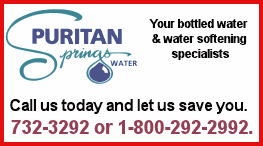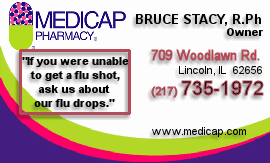|
Poison Prevention Week
 Send a link to a friend
Send a link to a friend
National Poison Prevention Week warns: Most child poisonings result
from common household products
Every
seven minutes, a child arrives at an emergency room due to a
suspected poisoning
[MARCH
24, 2005]
WASHINGTON, D.C. -- About 78,000 children under
5 years old visited U.S. hospital emergency rooms due to
unintentional poisonings in 2003 -- about one every seven minutes,
the U.S. Consumer Product Safety Commission reported. Most
of these poisonings included products commonly found in the home. |
|
The Consumer Product Safety Commission,
the National Poison Prevention Week Council and the American
Association of Poison Control Centers released the data at a news
conference to kick off National Poison Prevention Week, March 20-26.
Hal Stratton, chairman of the Consumer Product Safety Commission,
said that more than nine of every 10 suspected poison exposures
occur at home with readily available household products. About 30
children die from poisonings each year, down from 450 in the 1960s.
"While our nation has made great
progress in reducing poison-related fatalities, we must build on our
commitment to protect children from unintentional poisonings," urged
Stratton.
Parents can do their part, he noted,
by keeping harmful products and medicines out of children's reach,
storing items in their original containers and properly using
child-resistant packaging.

According
to the American Association of Poison Control Centers, centers
nationwide received more than 1 million calls in 2003 about poison
exposures involving children 5 years and younger. Among the
potentially toxic household products involved with calls to the
poison centers were:
- Personal care products, including
baby oil and mouthwash containing ethanol.
- Cleaning substances, including
drain openers and oven cleaners.
- Over-the-counter pain relievers
-- including ibuprofen, acetaminophen and aspirin -- and cough and
cold medicines.
- Hydrocarbons, such as lamp oil
and furniture polish.
- Adult-strength vitamins and
supplements containing iron.
[to top of second
column in this article]
 |

Rose Ann Soloway, chair of the
Poison Prevention Week Council, noted that when repackaged at home
in non-child-resistant containers, medicines and potentially
hazardous household products become even more accessible and
dangerous for young children. "Grandparents who keep their
prescription drugs in non-child-resistant pill boxes should be
especially aware of this risk," said Soloway. "Child-resistant
packaging doesn't work if it's not used properly."
Many poisoning incidents occur while
the products are in use and a parent or caregiver steps away or is
distracted for a moment. Children can get hold of a product and
swallow it during the short time it takes to answer a phone call or
doorbell.
"The alarming number of poison
center calls and emergency department visits proves that children
act fast, and so do poisons," said Kathy Wruk, president of the
American Association of Poison Control Centers. "Parents must act
fast as well. If your child swallows or handles a potentially
dangerous product, immediately call the poison center hot line at 1
(800) 222-1222. Your call will be answered by experts at your local
poison center."
[U.S.
Consumer Product Safety Commission news release provided by Logan
County Health Department and
Lincoln/Logan SafeKids Coalition]

|



